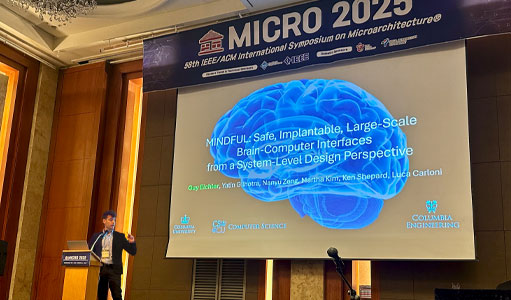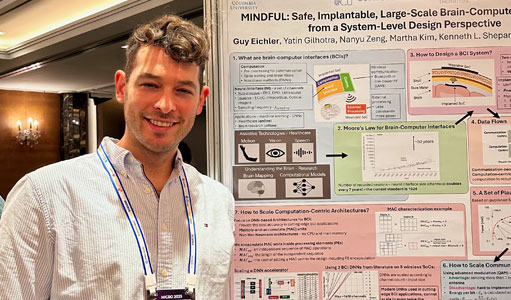Building Smarter Brain-Computer Interfaces
A new paper from CS researchers introduces MINDFUL, a framework designed to guide the design of modern implantable brain-computer interfaces (BCIs)—devices that connect the human brain directly to the digital world. The work is a call to action for the computer architecture community to help build BCIs that are not only safe and practical, but also ready to run advanced artificial intelligence applications for real-world healthcare.
The paper will be presented at the MICRO 58 conference on October 22, one of the leading forums for computer architecture research. The MINDFUL paper represents a milestone for the field. Its inclusion signals that implantable BCIs are no longer a niche or futuristic topic; they are a serious and emerging area of system design that demands attention from the broader computing community.

Rethinking How We Build Brain-Computer Interfaces
BCIs are rapidly evolving. Future systems are expected to wirelessly transmit vast amounts of brain data and use AI to translate thoughts into actions, such as moving a prosthetic limb or restoring speech. Yet, these implantable devices face stringent physical and power constraints that limit their complexity and functionality.
By analyzing a range of existing systems, the MINDFUL paper highlights a critical gap between today’s BCIs and the ambitious goal of building large-scale, AI-integrated devices. The framework provides a clear, quantitative approach to understanding these trade-offs, offering computer architects and hardware designers the tools to evaluate whether their designs are feasible, scalable, and safe.
“Until now, there hasn’t been a clear, accessible, and quantitative resource that captures the system-level challenges of implantable BCIs,” said Guy Eichler, the paper’s lead author. “MINDFUL changes that by offering a shared foundation for researchers and engineers who want to engage meaningfully with the field.”

A Framework for Collaboration and Innovation
The framework is expected to attract not only computer engineers but also AI developers and neuroscience researchers eager to advance the connection between computing and the human brain. For the first time, it gives designers a structured way to model and evaluate how key system parameters—such as data acquisition, on-chip computation, and wireless communication—interact under real-world constraints of implantables in the brain.
The impact of such advancements extends far beyond the lab. For patients living with paralysis, speech loss, blindness, or neurological disorders like Parkinson’s disease, implantable BCIs hold the promise of restored function and independence. These devices could one day decode brain signals in real time to help patients move prosthetic limbs, communicate, or even see again.
Eichler began exploring this topic during PhD studies in the Systems-Level Design Group led by Professor Luca Carloni. Where hands-on work designing and testing wireless, implantable BCIs revealed significant inconsistencies between how computer architects modeled these systems and how they behaved in practice. That experience inspired the creation of a framework to bridge the gap, translating the complexities of neurotechnology into a language familiar to engineers.
From Idea to Implementation
Now a postdoctoral scientist in the Bioelectronic Systems Lab with Professor Ken Shepard, Eichler continues to advance these systems toward clinical trials and eventual FDA approval, an effort supported by new patents and collaborations across neuroscience and engineering. Looking ahead, he says the research points to three distinct stages in BCI development: the pre-BCI era, focused on safety and data quality; the intra-BCI era, where AI computation becomes integrated into the devices themselves; and the post-BCI era, when computational power within BCIs will need to scale dramatically to support next-generation applications.
Beyond the technology, the work also aims to reshape public perception of BCIs. While ethical and privacy concerns are valid, the researcher emphasizes that BCIs have the potential to transform lives and deepen our understanding of the human brain.
“People are understandably cautious about the idea of brain implants,” Eichler said. “But BCIs represent one of the most powerful tools we have to treat neurological disorders and restore lost function. They’re not just about connecting brains to machines—they’re about reconnecting people to the world.”

